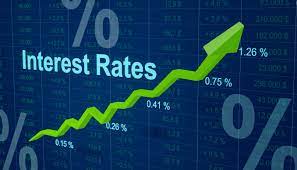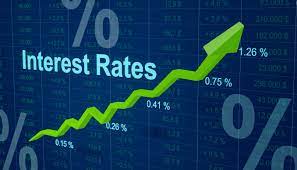
The Federal Reserve of the United States, the European Central Bank, the Bank of England, and the Swiss National Bank all raised interest rates by 50 basis points this week, as expected, but markets are focusing on their shifting tones.
Markets reacted negatively after the Fed raised its benchmark rate by 50 basis points to its highest level in 15 years on Wednesday. This was a slowdown from the previous four meetings, during which the central bank raised interest rates by 75 basis points.
However, Fed Chairman Jerome Powell indicated that, despite recent indications that inflation may have peaked, the battle to bring it back down to manageable levels is far from over.
“There’s an expectation really that the services inflation will not move down so quickly, so we’ll have to stay at it,” Powell said in Wednesday’s press conference.
“We may have to raise rates higher to get where we want to go.”
The European Central Bank followed suit on Thursday, opting for a smaller hike but implying that rates would need to be raised "significantly" further to tame inflation.
The Bank of England also raised interest rates by half a point, adding that it would "respond forcefully" if inflationary pressures became more persistent.
According to George Saravelos, head of FX research at Deutsche Bank, the major central banks have sent a "clear message" to the markets that "financial conditions must remain tight."
“We wrote at the start of 2022 that the year was all about one thing: rising real rates. Now that central banks have achieved this, the 2023 theme is different: preventing the market from doing the opposite,” Saravelos said.
“Buying risky assets on the premise of weak inflation is a contradiction in terms: the easing in financial conditions that it entails undermines the very argument of weakening inflation.”
Saravelos noted that the ECB and Fed's explicit shift in focus from the consumer price index (CPI) to the labor market is notable in this context, as it implies that supply-side movements in goods are insufficient to declare "mission accomplished."
“The overall message for 2023 seems clear: central banks will push back on higher risky assets until the labour market starts to turn,” Saravelos concluded.
The Fed's and ECB's hawkish messaging surprised the market somewhat, even though the policy decisions themselves were expected.
Berenberg adjusted its terminal rate forecasts on Friday in response to recent developments, adding an additional 25 basis point rate hike for the Fed in 2023, bringing the peak to a range of 5% to 5.25% over the first three meetings of the year.
“We still think that a decline in inflation to c3% and a rise in unemployment to well above 4.5% by the end of 2023 will eventually trigger a pivot to a less restrictive stance, but for now, the Fed clearly intends to go higher,” Berenberg Chief Economist Holger Schmieding said.
The bank also raised its expectations for the ECB, which it now expects to raise rates to "restrictive levels" at a steady pace for at least another meeting. Berenberg added a 50 basis point move on March 16 to its previous forecast of 50 basis points on February 2. The ECB's main refinancing rate now stands at 3.5%.
“From such a high level, however, the ECB will likely need to reduce rates again once inflation has fallen to close to 2% in 2024,” Schmieding said.
“We now look for two cuts of 25bp each in mid-2024, leaving our call for the ECB main refi rate at end-2024 unchanged at 3.0%.”
The Bank of England was slightly more dovish than the Fed and the ECB, and future decisions will most likely be heavily influenced by how the expected UK recession plays out. The Monetary Policy Committee, on the other hand, has repeatedly expressed concern about labor market tightness.
Berenberg anticipates another 25 basis point hike in February, raising the bank rate to 3.75%, followed by 50 basis point cuts in the second half of 2023 and another 25 basis points by the end of 2024.
“But against a backdrop of positive surprises in recent economic data, the extra 25bp rate hikes from the Fed and the BoE do not make a material difference to our economic outlook,” Schmieding explained.
“We still expect the U.S. economy to contract by 0.1% in 2023 followed by 1.2% growth in 2024 whereas the U.K. will likely suffer a recession with a 1.1% drop in GDP in 2023 followed by a 1.8% rebound in 2024.”
Berenberg does see the ECB's additional 50 basis points having a visible impact, restraining growth most visibly in late 2023 and early 2024.
“While we leave our real GDP call for next year unchanged at -0.3%, we lower our call for the pace of economic recovery in 2024 from 2.0% to 1.8%,” Schmieding said.
However, he noted that over the course of 2022, central banks' forward guidance and tone shifts have not proven to be a reliable guide to future policy action.
“We see the risks to our new forecasts for the Fed and the BoE as balanced both ways, but as the winter recession in the euro zone will likely be deeper than the ECB projects, and as inflation will probably fall substantially from March onwards, we see a good chance that the ECB’s final rate increase in March 2023 will be by 25bp rather than 50bp,” he said.
(Source:www.cnbc.com)
Markets reacted negatively after the Fed raised its benchmark rate by 50 basis points to its highest level in 15 years on Wednesday. This was a slowdown from the previous four meetings, during which the central bank raised interest rates by 75 basis points.
However, Fed Chairman Jerome Powell indicated that, despite recent indications that inflation may have peaked, the battle to bring it back down to manageable levels is far from over.
“There’s an expectation really that the services inflation will not move down so quickly, so we’ll have to stay at it,” Powell said in Wednesday’s press conference.
“We may have to raise rates higher to get where we want to go.”
The European Central Bank followed suit on Thursday, opting for a smaller hike but implying that rates would need to be raised "significantly" further to tame inflation.
The Bank of England also raised interest rates by half a point, adding that it would "respond forcefully" if inflationary pressures became more persistent.
According to George Saravelos, head of FX research at Deutsche Bank, the major central banks have sent a "clear message" to the markets that "financial conditions must remain tight."
“We wrote at the start of 2022 that the year was all about one thing: rising real rates. Now that central banks have achieved this, the 2023 theme is different: preventing the market from doing the opposite,” Saravelos said.
“Buying risky assets on the premise of weak inflation is a contradiction in terms: the easing in financial conditions that it entails undermines the very argument of weakening inflation.”
Saravelos noted that the ECB and Fed's explicit shift in focus from the consumer price index (CPI) to the labor market is notable in this context, as it implies that supply-side movements in goods are insufficient to declare "mission accomplished."
“The overall message for 2023 seems clear: central banks will push back on higher risky assets until the labour market starts to turn,” Saravelos concluded.
The Fed's and ECB's hawkish messaging surprised the market somewhat, even though the policy decisions themselves were expected.
Berenberg adjusted its terminal rate forecasts on Friday in response to recent developments, adding an additional 25 basis point rate hike for the Fed in 2023, bringing the peak to a range of 5% to 5.25% over the first three meetings of the year.
“We still think that a decline in inflation to c3% and a rise in unemployment to well above 4.5% by the end of 2023 will eventually trigger a pivot to a less restrictive stance, but for now, the Fed clearly intends to go higher,” Berenberg Chief Economist Holger Schmieding said.
The bank also raised its expectations for the ECB, which it now expects to raise rates to "restrictive levels" at a steady pace for at least another meeting. Berenberg added a 50 basis point move on March 16 to its previous forecast of 50 basis points on February 2. The ECB's main refinancing rate now stands at 3.5%.
“From such a high level, however, the ECB will likely need to reduce rates again once inflation has fallen to close to 2% in 2024,” Schmieding said.
“We now look for two cuts of 25bp each in mid-2024, leaving our call for the ECB main refi rate at end-2024 unchanged at 3.0%.”
The Bank of England was slightly more dovish than the Fed and the ECB, and future decisions will most likely be heavily influenced by how the expected UK recession plays out. The Monetary Policy Committee, on the other hand, has repeatedly expressed concern about labor market tightness.
Berenberg anticipates another 25 basis point hike in February, raising the bank rate to 3.75%, followed by 50 basis point cuts in the second half of 2023 and another 25 basis points by the end of 2024.
“But against a backdrop of positive surprises in recent economic data, the extra 25bp rate hikes from the Fed and the BoE do not make a material difference to our economic outlook,” Schmieding explained.
“We still expect the U.S. economy to contract by 0.1% in 2023 followed by 1.2% growth in 2024 whereas the U.K. will likely suffer a recession with a 1.1% drop in GDP in 2023 followed by a 1.8% rebound in 2024.”
Berenberg does see the ECB's additional 50 basis points having a visible impact, restraining growth most visibly in late 2023 and early 2024.
“While we leave our real GDP call for next year unchanged at -0.3%, we lower our call for the pace of economic recovery in 2024 from 2.0% to 1.8%,” Schmieding said.
However, he noted that over the course of 2022, central banks' forward guidance and tone shifts have not proven to be a reliable guide to future policy action.
“We see the risks to our new forecasts for the Fed and the BoE as balanced both ways, but as the winter recession in the euro zone will likely be deeper than the ECB projects, and as inflation will probably fall substantially from March onwards, we see a good chance that the ECB’s final rate increase in March 2023 will be by 25bp rather than 50bp,” he said.
(Source:www.cnbc.com)





